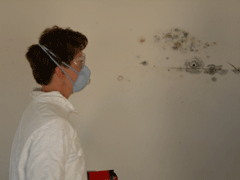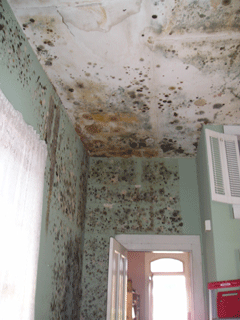New Orleans Health
Air Date: Week of September 8, 2006

Dr. Gina Solomon taking mold samples in New Orleans in 2005. (Photo courtesy of NRDC)
A year after Hurricane Katrina, critics of the EPA say the health hazards in New Orleans are under-researched and under-regulated. Living on Earth talks with Dr. Gina Solomon, a senior scientist with the Natural Resources Defense Council, who is on the ground in New Orleans testing the quality of the air, sediment, and water.
Transcript
GELLERMAN: Unfortunately, the unprecedented catastrophes of 9/11 and Hurricane Katrina have forced the United States to learn many lessons about the health and environmental consequences of disasters. But the lessons can be harsh and difficult. It can take years to investigate the effects on people and the places they live.
In New Orleans, The U.S. Environmental Protection Agency has given the city a clean bill of health and residents the green light to return to their homes. But some say environmental health hazards still plague New Orleans. Gina Solomon is a senior scientist with the Natural Resources Defense Council. She joins me from New Orleans where she’s collecting air and water samples.
Dr. Solomon, welcome to Living On Earth.
SOLOMON: I’m happy to be here.
GELLERMAN: We were just talking about the after-effects of 9/11 in New York City. What happened in New Orleans with Katrina was very different but are there any lessons to be learned? Are there any similarities?
SOLOMON: You know, five years after 9/11, and one year after Hurricane Katrina, it is really interesting to look at the parallels of these two major human health and environmental health disasters. And people in both places are concerned about their environmental safety, about chemical contaminants, and pollutants, and also about the health symptoms that many people are having, certainly in New York among the 9/11 workers, but also down in here in New Orleans.
GELLERMAN: I know that in New York City, there’s something, I think it is called World Trade Center cough and you have something called the Katrina cough. Any similarities?
SOLOMON: Yeah, I think there are some similarities and some differences. A lot of the air pollutants were quite different. In New York we were talking about very alkaline particulate matter that was severely irritating to the lungs along with all of the combustion products from everything that was burning. Here in New Orleans it was mostly organic matter, so it was sediments blowing around in the air and also mold spores and also endotoxin from bacteria. All of those kinds of things can irritate the lungs terribly but it’s a bit different both in terms of what it does to your lungs and also the kinds of long term health problems that we might think about.
GELLERMAN: Well, I know that the NRDC has been doing studies and sampling the environment down in New Orleans, and so has the EPA. Do your findings jibe?
SOLOMON: EPA has not done all of the same sampling we’ve done. In fact, we sampled for mold in New Orleans, and for endotoxin, and EPA has not sampled for either of these. So, our results are the only results published so far on mold concentrations in New Orleans in the air. EPA has been testing the sediment, and so have we. And our results, the numbers actually agree very well, but our interpretations are rather different.

Mold is still prevalent in many homes in New Orleans. It’s believed to be causing respiratory health problems among residents.(Photo courtesy of NRDC)
SOLOMON: We have been comparing the numbers with the EPA’s own clean up standards that they normally use for waste sites or any other facility that might be contaminated. And we’ve discovered that the arsenic levels, lead levels, diesel fuel levels and levels of other sooty contaminants are all over numbers that would normally trigger clean up, or at least investigation. EPA has dismissed those results saying that the contamination likely was present before the hurricane. Well, first of all I’m not convinced that it’s ok just to dismiss results even if the contamination pre-existed the hurricane. And secondly, they don’t even have any evidence to say that those levels were high before the hurricane, especially for the arsenic levels, which are quite high in the city.
GELLERMAN: Dr. Solomon, I understand that the EPA has given its approval to start bulldozing in the area that was struck by Katrina. Am I right about that?
SOLOMON: The EPA has announced that it’s not going to enforce its normal regulations on asbestos that may be generated from bulldozing places in New Orleans. That means that it’s possible that the asbestos levels in the air here could be quite high, especially for people right near where homes are being bulldozed. We’re down here to see if there’s a problem with asbestos in the air, and to do some independent sampling.
GELLERMAN: What do you find in terms of the people that were victims of the hurricane? Do they have faith in the EPA that their health and well-being is being looked after?
SOLOMON: The talk of the day down in New Orleans right now is about the 9/11 situation. I’m hearing person after person say, “We now know that the EPA wasn’t to be trusted in New York after 9/11, so why should we trust the EPA and what they’re telling us now after Katrina?” It seems ironic to people that EPA is announcing that the sediment is safe and that there are no toxic contaminants left behind from the flooding right at the same time that there’s information revealed that they gave a false all-clear in New York. So, there’s a lot of skepticism, a lot of mistrust, and EPA, frankly, has a long way to go to earn back people’s trust down here in New Orleans.
GELLERMAN: Dr. Solomon, thank you very much. Appreciate your time.
SOLOMON: Thank you.
GELLERMAN: Gina Solomon is a senior scientist with the Natural Resources Defense Council, and she joined us from New Orleans.
We contacted the EPA for a response to Dr. Solomon’s claims that the agency is not properly monitoring and testing for pollutants. Dale Kemery, a spokesperson for EPA says in fact they are testing for asbestos, mold and other pollutants, but he acknowledges that the agency will not be enforcing normal asbestos regulations in upcoming demolition projects in New Orleans.
KEMERY: EPA has not waved environmental or occupational rules for asbestos materials. What the agency did was to use its discretion for reasons of safety and flexibility. You see, certain residential buildings in Louisiana or Mississippi are unsound or uninhabitable for environmental reasons, so the agency is allowing those buildings to be torn down without inspection or removal of asbestos materials.
GELLERMAN: EPA spokesperson, Dale Kemery.
[MUSIC: Jocelyn Pook “Butterfly Song” from ‘Untold Things’ (Real World Records - 2001)]
Links
Living on Earth wants to hear from you!
Living on Earth
62 Calef Highway, Suite 212
Lee, NH 03861
Telephone: 617-287-4121
E-mail: comments@loe.org
Newsletter [Click here]
Donate to Living on Earth!
Living on Earth is an independent media program and relies entirely on contributions from listeners and institutions supporting public service. Please donate now to preserve an independent environmental voice.
NewsletterLiving on Earth offers a weekly delivery of the show's rundown to your mailbox. Sign up for our newsletter today!
 Sailors For The Sea: Be the change you want to sea.
Sailors For The Sea: Be the change you want to sea.
 The Grantham Foundation for the Protection of the Environment: Committed to protecting and improving the health of the global environment.
The Grantham Foundation for the Protection of the Environment: Committed to protecting and improving the health of the global environment.
 Contribute to Living on Earth and receive, as our gift to you, an archival print of one of Mark Seth Lender's extraordinary wildlife photographs. Follow the link to see Mark's current collection of photographs.
Contribute to Living on Earth and receive, as our gift to you, an archival print of one of Mark Seth Lender's extraordinary wildlife photographs. Follow the link to see Mark's current collection of photographs.
 Buy a signed copy of Mark Seth Lender's book Smeagull the Seagull & support Living on Earth
Buy a signed copy of Mark Seth Lender's book Smeagull the Seagull & support Living on Earth

